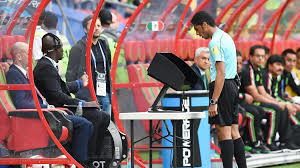What is a Video Assistant Referee (VAR)? « Back to Questions List
|
Video Assistant Referee (VAR) system is a mechanism to support the decision making process of a referee in a football match. The video assistant referee rules were approved as laws of football game by the International Football Association Board, after trails in many matches. In FIFA 2018 football world cup matches to be held in Russia, VAR will be utilized to support the match referee to review his decisions in the following four scenarios. a. Review of goals and offences/ violations during the buildup resulting in the goal. The above four situations are potential game changing situations capable of affecting even match result. The video assistant referee team will consists of a team of official referees, named assistant referees that reviews decisions made by the head referee in the football court. The review is made using video footage. The communication with match referee is through a headset. The match referee can overturn his earlier decision, if there was a clear or clear and obvious error. The review can be triggered by the match referee or by the VAR team. The assistance of VAR team can be sought by the referee by requesting a review. On the other hand VAR team can recommend a review to the field referee.
The video assistant referee team will be seated in a centralized video operation room. The VAR team will have access to broadcast cameras and dedicated cameras. They will be conducting simultaneous checks to ascertain whether they should recommend a review to the referee. If the VAR finds nothing during their check, no review is recommended and no communication is made with referee. This is termed a silent check. If the VAR ( head referee of the VAR team) believes that there is a potential error, he conveys the same to the referee. The referee can then decide on any of the following suitable options: The referee can stop the play to conduct an on-field review (OFR), but is not expected to do so when either team is in a good attacking possibility. In the other method, the referee himself can demand a review by VAR by making the outline of a rectangle with his index fingers (indicating a video screen). For the on-field review, the referee moves to a designated spot on the sideline, called the referee review area (RRA). The team of video assistant referee(s) and the assistant video assistant referee (AVAR) review the play on a bank of monitors arranged in the video operation room (VOR). Players who demand a video review or players entering RRA are to be awarded yellow card. Team officials entering RRA are to be dismissed. The rules of VRA say that slow motion should only be used for point of contact offences (physical offences or hand balls). Regular speed should be depended to decide the intensity of an offence and on deliberate handballs. Review of goals, penalty kick or red card decisions for denial of goal can be initiated from the initiation of attacking possession phase (APP).
The video assistant referee system will aid the match referee to take the most appropriate decision in game changing scenarios that may avoid goals like ‘ hand of God goal’ in future. FIFA World Cup- Evolution, Interesting Facts and RecordsFIFA World Cup Winners and Interesting Facts about the Final Rounds |

